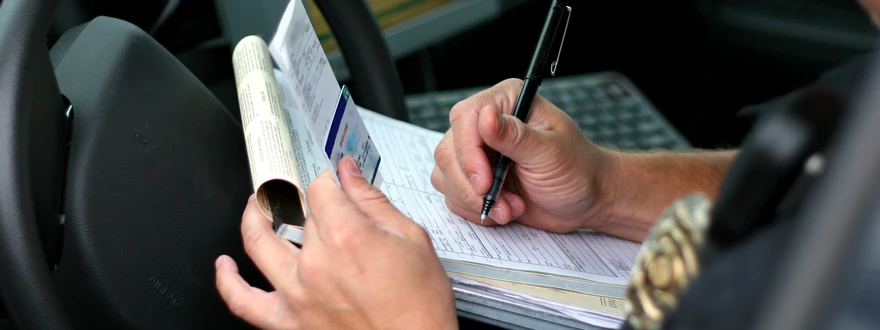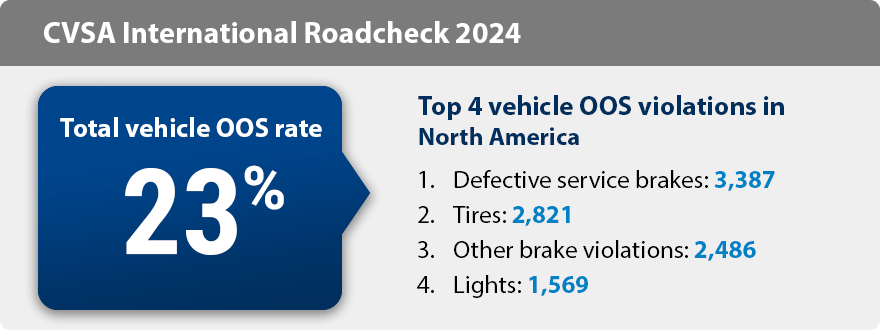From OOPS to OOS—avoid these 4 CVSA violations.

Imagine losing uptime to a broken lightbulb. The Commercial Vehicle Safety Alliance (CVSA) International Roadcheck happens every year. To some, these numbers are low enough to be acceptable. But each OOS vehicle violation is lost uptime and revenue.
If one of your vehicles is among the 23 percent with an OOS violation, hooray for those who passed every mark, but you’ve lost money you could have kept.
Whether or not any of your vehicles were issued an out-of-service (OOS) violation, let’s look at how fleet technology helps prevent each and bad-for-the-bottom-line downtime.
Violation 1: Defective service brakes
A vehicle receives an OOS violation if the number of defective brakes is equal to or greater than 20% of the service brakes on the vehicle or combination. Brakes are a consistent reason for vehicles being placed OOS, but proactive care helps prevent this violation (and ensure the vehicle has better stopping power).
How to prevent
Ensure proper, thorough pre- and post-trip inspections for each tractor and trailer.
- Use a straightforward, electronic inspection system that walks drivers through each step and zone.
- Verify each inspection online to ensure each vehicle is inspected, including those on long-haul trips and distant locations.
- Check each inspection zone’s timestamp to see if any part of the inspection was cut short or skipped.
- Set up alerts for when a vehicle is moved when an inspection is skipped.
Also use a fleet management platform that supports custom reports for these required inspections, and stay on top of defects, repairs, reports and inspection performance across your entire fleet.
Also see
Infographic: OOS highlights from CVSA 2024 Brake Safety Week
White paper: Control more costs with custom data visualizations.
Violation 2: Tire violations
Tires are your fleet vehicles’ only contact with the road. And yet, they’re the second most common OOS vehicle violation during the CVSA 2024 International Roadcheck. More to think about: Well-maintained tires mean fewer violations and are less likely to suffer a catastrophic failure. Plus, healthy tires help with fuel efficiency and ease the strain on your budget.
How to prevent
- Make sure vehicle inspections include checking for low tread depth, sidewall damage, improper inflation, audible air leaks.
- Coach safer, more efficient driving habits to reduce wear-and-tear and extend each tire’s lifespan.
- Consider a tire pressure monitoring system that also includes an inner tires and that alerts you to issues even while the vehicle is in motion.
- Replace tires proactively before they reach the legal tread minimum.
Also see
ROI calculator: How much could your fleet save with properly inflated tires?
Infographic: Keep tire pressure problems from becoming OOS violations
Violation 3: Other brake system violations
Brake problems outside of service brakes also earned some vehicles a place on the OOS sidelines. Inspectors flagged issues such as air brake system leaks, inoperative warning devices and improper adjustments.
How to prevent
- Ensure each of these items is included in your standardized electronic inspection procedures.
- Train each operator to look for and report defects they find as they check their vehicle.
- If necessary, customize your fleet’s inspection steps to include these components and issues.
- Proactively maintain vehicle health so that anything a driver may miss, is caught during regular service.
- Use brake stroke indicators to help drivers quickly spot adjustment issues.
See also
Checklist: Mind your inspections for freight trucks
White paper: Save costs with AI-powered, data-driven predictive maintenance.
Violation 4: Lighting violations
All 1,569 of these OOS vehicles violations probably could have been prevented by making sure all their lights were in place and working. Lights may seem minor, but they’re a safety concern. And they’re one of the first things inspectors will notice because they’re so visible.
How to prevent
- Have drivers do a full light check during inspections to catch burned out brake lights, head lights, turn signals and missing reflectors.
- Keep spares bulbs and fuses in every vehicle just in case something goes out during a trip.
- Outfit vehicles with telematics because some systems will alert you when a light goes out.
Time for your next step.
The CVSA 2024 Roadcheck showed that brakes, tires and lights still top the list of avoidable OOS vehicle violations. Key word: avoidable. And the right fleet tech will help prevent future OOS violations.
Not earning an OOS violation in 2024 doesn’t mean your fleet is always perfect. Just means none of your vehicles were caught during that CVSA campaign. If, on the other hand, one of your vehicles earned one of these violations, we’re not judging. We’re here to help you avoid any more.
Your fleet works hard for the money. Protect it from avoidable downtime. Contact us with questions. And tell us what you’d like to track and monitor.






